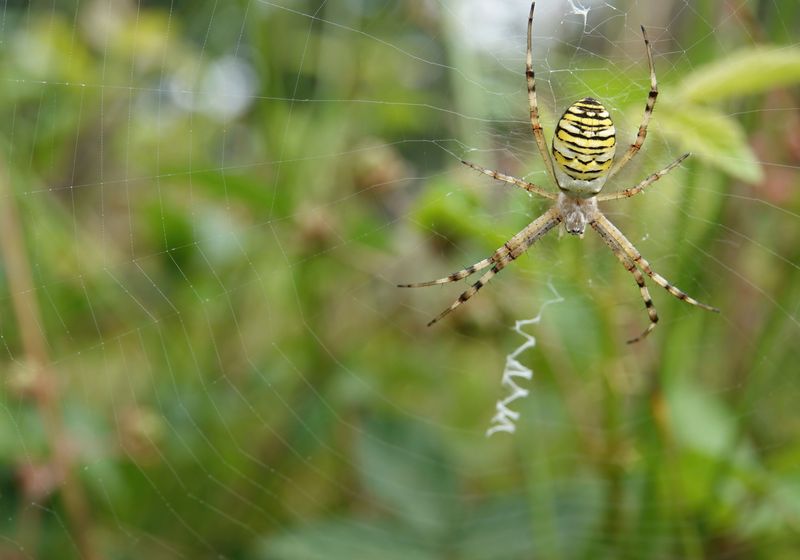Argiope bruennichi create decorative structures called stabilimenta. The ones shown as zig-zags here are in the “normal” stabilimenta geometry.
Whether tucked into the corners of a haunted house or shining with drops of morning dew between tree branches, spider webs are homes to the eight-legged critters. Like some species in the animal kingdom, certain spiders like to decorate their houses.1 Wasp spiders will often embellish their webs with structures called stabilimenta.
Researchers have wondered for decades why these spiders add extra decorative touches to their webs. Initially, some thought that the threads provide structural support to the web, but evidence has shown that’s not the case.2 Others posited that the silk structures perhaps attract prey, provide shade and water, or help protect the spider from predators.3-6
Now, in a new study published in PLOS One, researchers led by physicist and materials scientist Gabriele Greco at the Swedish University of Agricultural Sciences, discovered that when prey land on webs with intricate stabilimenta, the structures propagate waves in such a way that the spider can feel the impact in more locations around its web, likely helping it find and capture its prey.7 In addition to providing more insight into the role of these structures, the results have implications for the design of new biology-inspired materials.
Argiope bruennichi creates stabilimenta with different geometries. a) A. bruennichi producing silk. b) A juvenile A. bruennichi in the center of its web with the stabilimentum (courtesy of Letizia Alleruzzo, Aracnofilia – Italian Association of Arachnology). c– h) The different types of stabilimenta: normal (N), juvenile (J), reduced (R), platform (P), drafted (D), and absent (A).
Greco et al., 2025, PLOS One, CC-BY 4.0.
Greco and his colleagues first surveyed three different populations of wasp spiders, Argiope bruennichi, which often decorate their webs with stabilimenta. They found that these spiders create a variety of stabilimenta with different geometries: a circular platform (P) around the center of the orb-shaped web, zig-zags around the platform that are most commonly made by juvenile spiders (J), zig-zags extending upward and downward from the center of the web called “normal” (N), only the downward zig-zag named “reduced” (R), an incomplete or thin strands form called “drafted” (D), or absent stabilimenta (A).
They then simulated how prey landing on the different stabilimenta geometries altered the waves produced in the web. If a simulated insect landed perpendicular to the web surface, or if it ran into the side of the web perpendicular to the typical spirals of the web, the presence of P, J, N, R, or D stabilimenta or their absence had no effect on how the waves propagated.
However, if the prey landed on the web along the same direction as the spirals—in other words, tangential to the spirals—the presence of the stabilimenta geometries propagated the waves to more points on the web, theoretically making it easier for the spider to sense and capture its meal.
“This study reveals that the decorative stabilimentum in Argiope bruennichi webs is more than just ornament, for it subtly changes how certain vibrations travel through the web,” said the study authors in a statement.
Spiders, it turns out, value both beauty and function, when building their homes.
- Diamond, J. Animal art: Variation in bower decorating style among male bowerbirds Amblyornis inornatus. Proc. Natl. Acad. Sci. U.S.A. 1986;83(9):3042-3046.
- Eberhard W. Spider webs: behavior, function, and evolution. The University of Chicago Press. 2020.
- Humphreys WF. Stabilimenta as parasols: shade construction by Neogea sp. (Araneae: Araneidae, Argiopinae) and its thermal behaviour. Bull Br Arachnol Soc. 1990;9:47-52.
- Walter P, et al. Argiope bruennichi shows a drinking-like behaviour in web hub decorations (Araneae, Araneidae). J Ethol. 2009;27:25–29.
- Kim KW, et al. Functional values of stabilimenta in a wasp spider, Argiope bruennichi: support for the prey-attraction hypothesis. Behav Ecol Sociobiol. 2012;66:1569–1576.
- Yeh C-W, et al. Top down and bottom up selection drives variations in frequency and form of a visual signal. Sci Rep. 2015;5:9543.
- Greco G, et al. The effect of different structural decoration geometries on vibration propagation in spider orb webs. PLoS One. 2025;20(10):e0332593.

